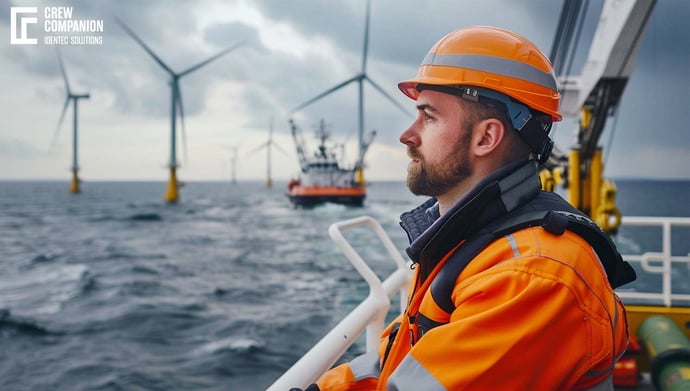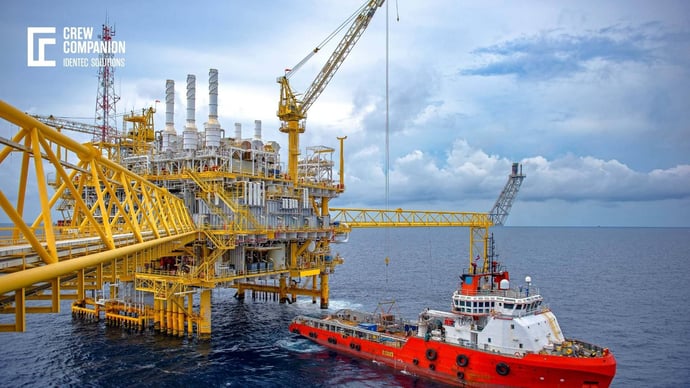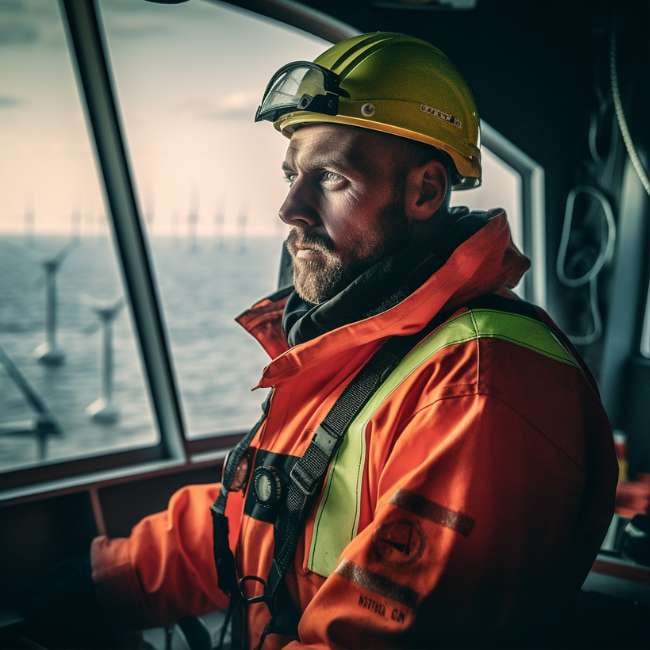Crew Attendance and Electronic Technologies
| Written by Michal Wozniakowski-Zehenter
This article will explore different technologies, particularly SOVs. We will delve deeper into their mechanisms, advantages, challenges, and role in shaping the future of crew management in offshore operations.

No video selected
Select a video type in the sidebar.
Why SOVs?
SOVs – Service Operation Vessels – are specialized ships designed to support offshore installations, especially in the wind energy sector. Their goal? Bringing maintenance crews to offshore installations, providing logistical support and offering accommodation for the working personnel. Movement of the people on and off the vessel, through the walk-to-work gangway, is high, especially in huge wind parks located in the North Sea. Given this significant number of personnel on board, which can be up to 60 people, with 40 people leaving the vessel, and the importance of ensuring their safety, accurate Personnel on Board (POB) list is crucial. Luckily, electronic crew attendance technologies help SOV operators manage personnel movements effectively while complying with regulatory requirements.
Crew Attendance – Importance of the POB List
An accurate POB List is important for several reasons. “Safety first” is not just a slogan – it’s actually the biggest concern. In the event of an emergency, a fire or an evacuation scenario, knowing exactly who is on board a quick and effective response easier. “Always-up-to-date” POB List help to ensure that all crew members are accounted for during search and rescue operations.
Compliance with maritime regulations is another key reason. Regulatory bodies require correct records of all personnel on board offshore vessels to maintain high safety standards. Failing to comply with these requirements can lead to penalties or operational restrictions.
Efficient logistical management is also directly tied to POB lists. SOV operators need to handle crew rotations, transfers between installations, and maintenance schedules. Accurate crew data helps to optimize these operations, reducing downtime and improving productivity. It’s when the captain, HSE officer, and operational management on shore have a clear view of who is on board and their respective roles. This helps ensure that personnel resources are used effectively, contributing to smoother and more productive operations.
Technologies for Electronic Crew Attendance
RFID technology is widely used in electronic crew attendance systems. It involves the use of RFID tags, which store crew identification information and readers that detect and record the presence of these tags within a certain range. The tags are often embedded in crew members' identification badges or worn on a lanyard or as a wrist watch, enabling automated and continuous attendance tracking but also some versions of access control. One of the main benefits is the ability to provide real-time monitoring of personnel movement within designated areas. The technology can also operate in a hands-free manner, eliminating the need for manual scanning or interaction. Solutions using RFID technology are giving an advantage to SOV operators because they allow for automatic and continuous updates of POB lists. This real-time information is crucial in emergencies, enabling rescue teams to quickly identify the location of crew members.
Smart card-based systems are also commonly used for electronic crew attendance management. Crew members are issued cards that store their identification data. When scanned by readers at key access points, the system automatically updates attendance records. This system offers custom access control, allowing operators to restrict access to sensitive areas to authorized personnel only. Each card swipe provides attendance tracking, keeping POB lists accurate. On SOVs, smart card-based access control systems are used not only to monitor crew attendance but also to secure areas like control rooms, workshops, and accommodation facilities. The challenges include the potential loss or theft of cards, which can pose security risks. Additionally, card sharing between crew members can compromise attendance accuracy.
QR codes and barcodes represent a low-cost alternative for electronic crew attendance management. Crew members are issued badges with unique QR codes or barcodes, which can be scanned at access points to update attendance records. They are relatively inexpensive to implement and offer accurate identification when scanned properly. However, the primary limitation of those systems is that they require manual scanning, meaning attendance tracking is not fully automated, and as we know, human errors might happen. The dependence on physical badges means again, that lost or damaged badges could hinder identification.
Electronic logbooks and crew management software provide a centralized platform for managing crew data, including attendance, and training. These systems can either be updated manually or synchronized with other electronic attendance systems for real-time data entry. The primary benefit of electronic logbooks is the centralized data management they offer. All crew information is available in one place, simplifying compliance reporting and logistical management. Additionally, customizable alerts can notify supervisors about crew rotations, training needs, and certifications. These systems are particularly useful for managing large SOV crews and ensuring that all personnel are properly trained and certified. However, the reliance on manual data entry can lead to errors, and integrating the software with other attendance systems can be challenging (see also: electronic T-card systems).
Crew Attendance Challenges
Electronic crew attendance systems collect sensitive data that can be vulnerable to cyberattacks. Making sure that data security and privacy are in place is very important in protecting crew members' information and maintaining the integrity of POB lists. They should have implemented additional features like end-to-end encryption, multi-factor authentication, and regular security audits. Crew members should be made aware of the data collection practices to build trust in the system. To encourage the adoption and acceptance of the crew, SOV operators should conduct awareness campaigns and provide training on the use and benefits of electronic crew attendance systems. Building trust in the system is crucial for achieving reliable POB management.
Offshore operations are controlled by diverse regulatory requirements that vary across jurisdictions and countries. Meeting these requirements is essential for maintaining high safety standards and avoiding penalties. Attendance systems must be designed to comply with international maritime safety and data protection regulations. This also requires regular audits and updates to ensure compliance to always-evolving regulatory standards.
On the flip side, environmental factors, equipment malfunctions, and human errors can all affect the accuracy and reliability of electronic attendance systems. To improve it, systems should be regularly calibrated and maintained. Crew members should be trained in the proper use of these devices to minimize human errors.
The Future of Crew Attendance
With the broader availability of 5G connectivity, improvements in monitoring systems go hand in hand. Faster data transmission will enable seamless real-time tracking of personnel and provide better remote access to crew management systems. With 5G, SOV operators will be able to access crew attendance data remotely, enabling faster decision-making and improving operational efficiency.
What will definitely have a big impact in the future is Artificial Intelligence and machine learning. Predictive analytics powered by AI will help predict crew health risks and optimize crew rotations based on historical data and current trends. Machine learning algorithms will also be used to automatically flag suspicious activity, such as unauthorized access to restricted areas. This will enhance security and enable proactive risk management.
Augmented reality (AR) systems are there too, to transform crew training and introduction processes. By providing training experiences, AR will help new crew members familiarize themselves with SOV facilities and safety protocols. In maintenance support, AR systems will allow remote experts to guide crew members through repairs and maintenance tasks. This will improve the accuracy of repairs and reduce the need for on-site experts.
FAQ
What is crew attendance on SOV?
Crew attendance on a Service Operation Vessel (SOV) involves managing personnel to ensure optimal staffing, proper scheduling, and full qualifications. Roles include bridge and engine crew, service personnel, logistics staff, hospitality staff, and safety officers. Attendance is tracked through manual sheets or automated systems like RFID badges and digital management software. Shift management ensures compliance with work/rest regulations, while qualification checks confirm up-to-date certifications. Absence management and crew welfare, including quality accommodations and medical support, are prioritized. Effective attendance management ensures safety compliance, operational efficiency, and high crew morale.
What is the POB List?
A Personnel on Board List (POB List) is an official document that provides a comprehensive record of all individuals currently present on a vessel, platform, or offshore installation. It includes essential information about each person, such as their full name, position, company affiliation, and emergency contact details. The POB List plays a crucial role in maritime safety by ensuring that the whereabouts of all personnel are known at any given time. This accurate and up-to-date record is vital in emergency situations, as it assists in accounting for everyone during evacuations and rescue operations. Additionally, it helps operators manage crew rotations, logistical arrangements, and compliance with maritime regulations, making it an indispensable tool in the efficient and safe management of offshore operations (read also more about the Crew Companion Heliport app).
IN AN EXPERT EYE
We need to understand from our customers their objectives, what they want to improve or if they have a specific problem area. Electronic Crew Attendance offers improved safety and efficiency as the solution displays “Real-Time” visibility during emergency mustering or evacuation. Our Crew Companion Solution uses tags and readers to display location information, allowing access or creating real-time reports. The solution is fully automated and there is no need for swiping cards or the use of other manual methods in the event of emergencies or panic situations, no user interaction is required, this allows rapid personnel count of mustered personnel and rapid movement of personnel through chokepoints. The Crew Companion Solution provides visibility for all emergency response teams and organisations with immediate offshore & onshore display screen visibility in “Real-Time.”
— David Gordon, VP Sales Safe Energy, Identec Solutions
TAKEAWAY
Electronic crew attendance technologies are truly transforming personnel management on offshore vessels, especially on SOVs. They make sure that POB lists are accurate and that everything happens in real time, improving emergency response capabilities and supporting logistical management. Technologies such as RFID, smart cards, QR codes, and wearable devices offer unique advantages in managing crew attendance. However, challenges, naming, data security, system interoperability, and crew adoption must be addressed to effectively implement these systems. And as the maritime hand with the renewable energy industry continues to evolve, crew attendance systems will play an even bigger role in improving the safety, efficiency and compliance of offshore operations. SOVs can and are setting new standards in crew management, contributing to a safer and more productive industry.
Delve deeper into one of our core topics: Personnel on board
Further reading:
(1) https://boatwatch.org/safety-at-sea/understanding-emergency-notification-devices/

Author
Michal Wozniakowski-Zehenter, Marketing Manager
Michal Wozniakowski-Zehenter is an experienced marketing and project management professional. He spent most of his career on projects with a strong focus on digital marketing and event management. He is a very active voice representing offshore and mining industries through social media channels. Michal writes mainly about offshore oil and gas, renewable energy, mining and tunnelling. Compiling and sharing the knowledge within industries is one of his goals.





